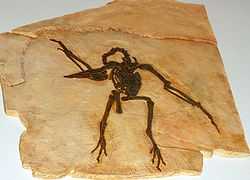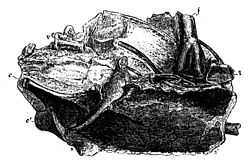Lithornithidae
| Lithornithidae Temporal range: Paleocene-Eocene, 56–40Ma Possible Cretaceous reccord | |
|---|---|
 | |
| Pseudocrypturus cercanaxius fossil cast, Zoologisk Museum, Copenhagen | |
| Scientific classification | |
| Kingdom: | Animalia |
| Phylum: | Chordata |
| Class: | Aves |
| Order: | †Lithornithiformes |
| Family: | †Lithornithidae Houde, 1988 |
| Genera | |
|
Lithornis | |
Lithornithidae is an extinct, possibly paraphyletic[1] clade of early paleognath birds. They are known from fossils dating to the Upper Paleocene through the Middle Eocene of North America and Europe, with possible Late Cretaceous representatives.[2][3] All are extinct today.[4]

Lithornithids had long, slender, bills for probing. They closely resembled modern tinamous. They possessed a rhynchokinetic skull with relatively unfused cranial bones, a weakly fused pygostyle and a splenial. They had a strongly developed keel on the sternum. The smaller members in genus Lithornis and Pseudocrypturus were good fliers, but the heavier Paracathartes was probably only a facultative flier. The unguals were more curved than in tinamous and probably allowed better perching in trees.
The order Lithornithiformes was erected by Dr. Peter Houde in 1988. Three genera are included; Lithornis, Paracathartes, and Pseudocrypturus. There are eight known species.[4] Promusophaga (Harrisson & Walker, 1977) may belong in Lithornithiformes too.
References
- ↑ Paleogene Fossil Birds
- ↑ Paleogene Fossil Birds
- ↑ A lithornithid (Aves: Palaeognathae) from the Paleocene (Tiffanian) of southern California
- ↑ 4.0 4.1 Houde, Peter W. (1988). "Paleognathous Birds from the Early Tertiary of the Northern Hemisphere". Publications of the Nuttall Ornithological Club (Cambridge Massachusetts, USA: Nuttall Ornithological Club) 22.